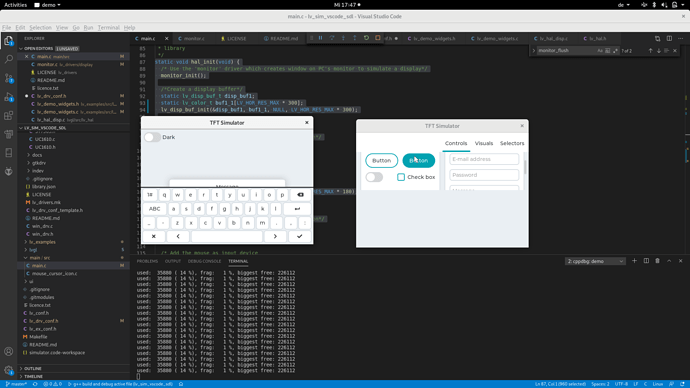Hi,
hope somebody here tried it and succeeded already at this task.
Description
I have the simulator running with 2 (fake) displays (2 display drivers, 2 display buffers, 2 monitors). Is the 2 monitors step necessary or could I draw the 2 displays on 1 “monitor” ?
My main question would be, if it is easily possible to add another display. Do I have to add a monitor_flush3() function for that ? Sorry, it is my first day of trying lvgl and I obviously did not read the whole documentation document.
What MCU/Processor/Board and compiler are you using?
Just the simulator on Fedora Linux, it compiles fine.
What LVGL version are you using?
I am using this example : https://github.com/lvgl/lv_sim_vscode_sdl
Uses LVGL v7
What do you want to achieve?
Extend the example in order to have 3-4 simulated displays.
What have you tried so far?
I am currently stuck on the 2 simulated display solution; I set the flag
MONITOR_DUAL to 1 and added a second display driver, display buffer, which uses monitor_flush2() instead of monitor_flush(). Is it now mandatory to add a monitor_flush3() for a 3rd fake display ?
Code to reproduce
static void hal_init(void) {
/* Use the 'monitor' driver which creates window on PC's monitor to simulate a display*/
monitor_init();
/*Create a display buffer*/
static lv_disp_buf_t disp_buf1;
static lv_color_t buf1_1[LV_HOR_RES_MAX * 300];
lv_disp_buf_init(&disp_buf1, buf1_1, NULL, LV_HOR_RES_MAX * 300);
/*Create a display*/
lv_disp_drv_t disp_drv;
lv_disp_drv_init(&disp_drv); /*Basic initialization*/
disp_drv.buffer = &disp_buf1;
disp_drv.flush_cb = monitor_flush;
disp_handle = lv_disp_drv_register(&disp_drv);
/*Create a display buffer*/
static lv_disp_buf_t disp_buf2;
static lv_color_t buf1_2[LV_HOR_RES_MAX * 180];
lv_disp_buf_init(&disp_buf2, buf1_2, NULL, LV_HOR_RES_MAX * 180);
/*Create a display*/
lv_disp_drv_t disp_drv2;
lv_disp_drv_init(&disp_drv2); /*Basic initialization*/
disp_drv2.buffer = &disp_buf2;
disp_drv2.flush_cb = monitor_flush2;
disp2_handle = lv_disp_drv_register(&disp_drv2);
//now add a third buffer, display, flush-call ?
...
}
Screenshot and/or video
Now I got 2, but I want 3-4 displays and would appreciate suggestions for correctly simulating several physical displays.
